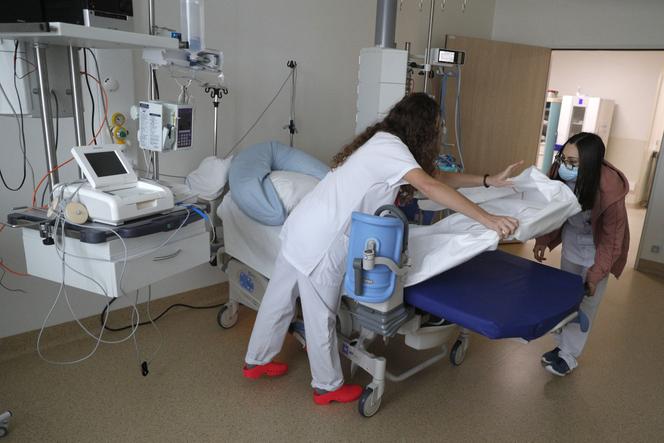 Midwives prepare a delivery room in the maternity ward of Ajaccio hospital, January 18. PASCAL POCHARD-CASABIANCA / AFP
Midwives prepare a delivery room in the maternity ward of Ajaccio hospital, January 18. PASCAL POCHARD-CASABIANCA / AFPIt’s a trend that no industrialized country can escape – artificial induction of labor is on the rise. While in some cases it is necessary, such as when the patient is overdue (which in France is 41 weeks and five days of amenorrhea), premature rupture of the water sac or high blood pressure – it is also increasing among women who have no medical indication for inducing labor. It can occur at 40 weeks or even 39 weeks.
In the US, the induction rate jumped to over 30% in 2020. In Europe, all countries are concerned by an increase, even the Scandinavians, renowned for their limited medicalization of labor which involves inducing uterine contractions. Several methods are available, such as intravaginal use of prostaglandins or balloon insertion into the cervix.
In France, while the induction rate was fairly stable at around 22% between 2010 and 2016, it climbed to almost 26% in 2021, according to the results of the latest national perinatal survey. “We’re probably well above that today. All regions and all maternity units, whatever their size or status, are concerned,” said Camille Le Ray, a gynecologist-obstetrician at the Port-Royal hospital (AP-HP) at a round table on the subject at the Journées Nationales de la Société Française de Médecine Périnatale in Nancy, which ran from October 16 to 18.
This trend has become evident since the Arrive trial, its results published in August 2018 in The New England Journal of Medicine. The randomized study of more than 6,106 low-risk nulliparous women (who had never given birth before) was carried out by the team of William Grobman, a specialist in fetal medicine. It showed that induction at 39 weeks (eight and a half months) would reduce the caesarean section rate to 18.6%, compared with 22.2% in cases where labor is induced naturally. This was true even if the cervix was completely closed. It also demonstrated a lower rate of gestational hypertensive pathologies. However, the results showed little significant difference in perinatal mortality.
Sensitive questions
Induction has long been thought to increase the risk of Caesarean section, but the Arrive trial overturned this paradigm. In an immediate response, the American College of Obstetricians and Gynecologists deemed it reasonable to propose and accept induction without medical indication at 39 weeks in the US.
In France, Grobman’s trial has received mixed reviews. Induction of labor without a proven medical reason is controversial among health-care professionals. It rekindles the ever-sensitive questions about the medicalization of pregnancy and childbirth, and about paternalistic medicine dictating to women what they should do. “It’s necessary to respect women’s choice after they’ve been given accurate information. Every day, in my maternity hospital [Hôpital Saint-Joseph, Paris], a woman asks me to be induced at 39 weeks for various reasons. Conversely, some women who need to be induced refuse. We have to listen to their requests,” said Elie Azria, head of the maternity unit.
You have 48.81% of this article left to read. The rest is for subscribers only.
